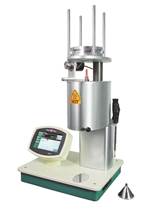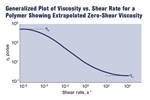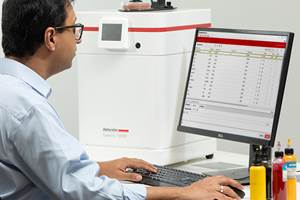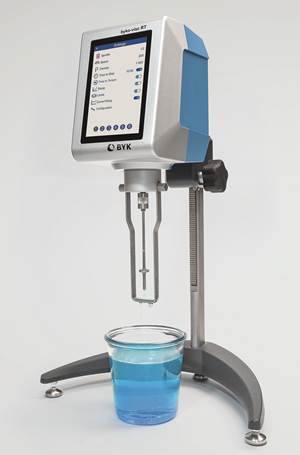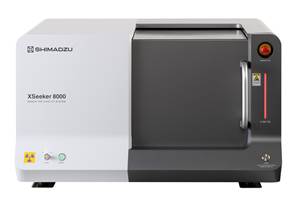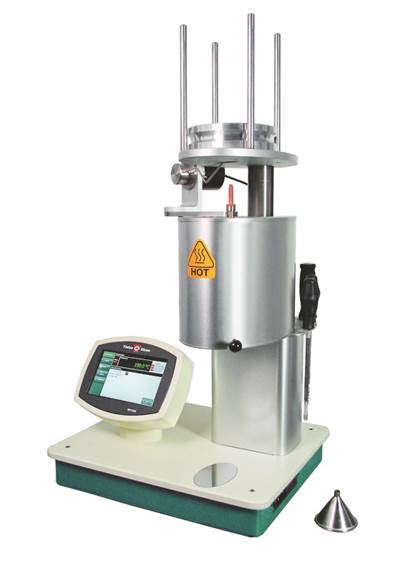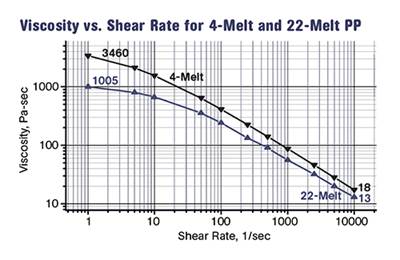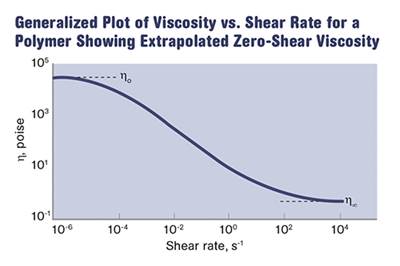MATERIALS: Melt Flow Rate Testing—Part 10
Two areas where the melt flow rate test it is not useful are related to processing.
Melt flow rate testing, like any method of evaluating material characteristics, is helpful when it is used for its intended purpose. Two areas where it is not useful are related to processing. One of these is the need for an accurate assessment of flow characteristics under typical processing conditions. This is generally thought of among processors as a measurement of viscosity.
Viscosity in polymers is dependent upon temperature and shear rate, and melt flow rate (MFR) testing typically fixes the temperature at a constant value for a given polymer and cannot control shear rate. Capillary rheometry is typically used to capture the temperature dependence and shear-rate dependence of viscosity, and curves of viscosity versus shear rate at multiple temperatures are required in flow simulation software so that the actual inputs provided by the analyst can be interpreted by the software. Applicable shear rates can vary from relatively low for processes like blow molding to very high for processes like injection molding, so characterizing behavior across a wide range of shear rates is important.
While the predictions made by simulation software continue to improve over time, there are still some problems that have defied a precise solution. Part of the reason for this is that even with the enhanced capabilities of a capillary rheometer, these lab instruments do not replicate what is happening in many real-world processes, particularly in a process involving a closed mold. The MFR test and capillary rheometry both utilize an open system and a flow path where all of the material is molten.
However, in the real world of injection molding, for example, a frozen layer begins to develop along the flow path almost immediately and becomes thicker with time, comprising a larger and larger percentage of the flow path cross-section as the material cools. This means that the size of the effective flow path, which is the most important term in the equations that describe polymer flow, is continually changing in a manner that the lab instrumentation does not recognize or account for.
In addition, these instruments do not account for shear-induced flow imbalances that can cause a temperature gradient to develop within the layers of flowing material. Much of the industry has been in denial regarding this phenomenon since it was first discussed by John Beaumont in the late 1990s, and there are important questions that remain regarding its magnitude and its effect on processing and part quality. But ongoing work makes it clear that this is a factor that must be considered in order to arrive at a precise assessment of the way in which polymers flow. Even if the MFR tester could be instrumented to measure this behavior, it cannot produce or control the shear rates needed create the conditions where the phenomenon could be measured.
The second shortcoming of lab instruments designed to characterize viscosity is their inability to account for or measure melt elasticity. Most of us have heard at some point in our careers that polymers are viscoelastic materials. This means that they simultaneously exhibit the characteristics of elastic solids and viscous fluids, and the compound response of any material is some combination of these two factors that varies with temperature and shear.
Viscoelastic behavior gets a lot of attention when polymers are in the “solid” state in their end-use environment. The viscous flow component, which appears to be a minor contributor to overall performance, is a consideration in phenomena such as creep, stress relaxation, and fatigue.
In the molten state, when most of us think of the polymer as a fluid, some remnants of elastic behavior remain. The elastic characteristics tend to be most important in high-viscosity systems and therefore appear at their greatest when melt temperature and shear rates are low and molecular weight is high. In blow molding and extrusion, melt elasticity manifests as die swell.
But it also appears in processes such as injection molding and plays a large part in causing many of the cosmetic defects that plague processors, particularly around gates and at weld lines.
An attempt was made in the early 1990s to develop an instrument that could measure melt elasticity simply. Bryce Maxwell, one of the more creative minds from the early era of plastics and a professor at Princeton, developed an instrument that he called a melt elasticity index (MEI) tester. This device was intended to provide a simple means of capturing the elastic properties of a melt just as the MFR tester is designed to simply measure viscous flow. The MEI tester also captured the elastic recovery properties, something that much more sophisticated rheological instruments failed to accomplish.
It consisted of a heater that allowed the operator of the device to control the temperature of a material sample that was positioned on a flat plate and heated to the test temperature. A second disk-shaped plate was then placed on top of the sample and pressed downward. As the polymer flowed, it formed a specimen of controlled thickness between the two plates. A drive motor then rotated the upper disk, shearing the specimen with respect to the lower plate. After a specified amount of deformation was applied, the upper disk was released from the drive and it then rotated in the opposite direction, propelled by the elastic recovery of the specimen. A dial and pointer on the top disk provided a means of quantifying the material response. This was observed and documented with a video camera.
Dr. Maxwell demonstrated the device at a few SPE ANTEC meetings, but it never went through the rather lengthy vetting process needed to bring it into the world of established laboratory instrumentation. It was, however, capable of distinguishing between materials of different melt elasticity, even when the melt viscosity of the materials appeared to be comparable, and it did so in a matter of minutes and at conditions similar to those associated with some processing methods.
If developed, it would have likely represented the same type of lower-cost alternative to parallel-plate or cone-and-plate rheometry that the MFR test represents when compared with capillary rheometry. This would permit processors to make useful, if approximate, measurements of melt elasticity that would provide another piece of the puzzle that is polymer flow.
We have now completed our tour of the MFR test. Hopefully, we have been able to clarify those things for which it is intended to be used and have dispelled some of the myths surrounding the numbers that come out of the test.
However, I suspect that confusion will continue for many in the industry. Just as I was finishing up this article, I received an e-mail from a compounder that provides PC/ABS alloys to the automotive industry in India. The compounder’s customers are complaining that sometimes the parts that they mold exhibit cracks in thin sections and they claim that this happens when the MFR of the raw material declines from 6 g/10 min to 4 g/10 min. This assertion reflects a poor understanding of the relationship between MFR and the manner in which polymers flow when subjected to real-world processing conditions.
Related Content
Datacolor Acquires Matchmycolor
The acquisition of the specialist in color formulation and communication software further expands Datacolor’s global industry presence in color management.
Read MoreRobust Rotational Viscometer
Versatile viscometer line said to offer robust measurement, repeatability and reporting.
Read MoreX-Ray Vision Inside Parts Gets More Affordable for Processors
Shimadzu’s new benchtop x-ray CT scanner provides internal and external metrology and flaw detection at a fraction of the previous cost.
Read MoreTracing the History of Polymeric Materials -- Part 30: Polyurethane
In the world of polymers, polyurethane chemistry is probably the most versatile. This a resulted in a wide range of products made from these materials and given the industry the flexibility to respond to the progressive march of regulatory concerns.
Read MoreRead Next
Melt Flow Rate Testing–Part 1
Though often criticized, MFR is a very good gauge of the relative average molecular weight of the polymer. Since molecular weight (MW) is the driving force behind performance in polymers, it turns out to be a very useful number.
Read MoreMelt Flow Rate Testing – Part 2
To fully appreciate the strengths and weaknesses of the melt-flow-rate (MFR) test it is important to know something about the way the test is performed.
Read MoreMelt Flow Rate Testing—Part 3
There is a well-established relationship between something called the weight-average molecular weight of a polymer and a parameter known as the zero-shear viscosity.
Read More
.jpg;width=70;height=70;mode=crop)
